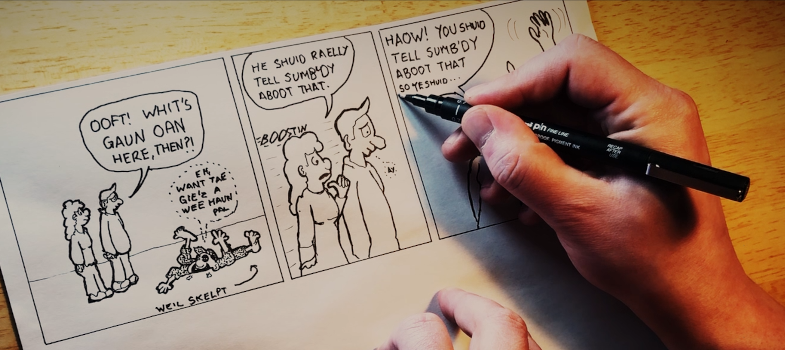Connecting with Scottish literature
Section 2, Activity 3
In
examining the two poems, Jane
Haining and A
Dochter’s Dreame, I
have referred to Lewis Grassic Gibbon’s Sunset
Song, and
Elizabeth Melville’s Ane
Godlie Dreame respectively. Reading
literature other than one’s own is a fundamental part of the
process of writing. When I came across the truly amazing story of
salt-seller Maggie Dickson, I instantly recognised that her story was
very similar to that of Effie Deans, a character in Sir Walter
Scott’s The
Heart of Midlothian, which
I had dramatized for BBC Radio 4’s Classic Serial. It is a great
novel of huge scope, giving a deeply layered sense of the period –
the mid 18th century
– contemporary with Maggie Dickson. So, when I discovered Maggie, I
already had, from The
Heart of Midlothian,
an understanding of the background to her story – a vivid sense of
Edinburgh life, its poverty and wealth, the Scottish legal system
(which judged and condemned women with terrible cruelty), the
richness of the Scots language, which Scott writes into his dialogue
with tremendous natural bravura, humour and tenderness. In other
words, the world described by Scott in The
Heart of Midlothian gave
me instant access to Maggie’s life.
Take a note in your Learning Log (opens in new tab) when working through these points:
1. When listening to the recordings below, note down your first impressions of the poem:
-
me reading Hauf-hingit Maggie on Soundcloud
-
watch and listen to me reading Hauf-hingit Maggie on Youtube.
2. Then read the poem and identify key words I used to describe Maggie’s feelings.
3. Think of a classroom research activity that can help pupils develop a better understanding of women’s lives in the 18th century.
Hauf-hingit Maggie
Margaret ‘Maggie’ Dickson, Musselburgh, 1702–1765; a salt-seller;
hanged for alleged murder of her illegitimate child; she strongly denied the charge.
Daith is wappin whan it comes – like birth;
I ken – I hae warstled throu, an focht wi baith.
She wis blue, ma bairn, blue as the breist o a bird
I seen oan the banks o the Tweed thon day; then grey,
aa wrang, the naelstring windit ticht aroon her neck;
I ettled tae lowse it, aince, twice, but it aye slippit –
ma hauns couldnae grup, ma mind skailt
frae the jizzen fecht, ma mooth steikit:
no tae scraich, no tae scraich, lat nane hear…
I stottert oot, doon tae the watter, thocht tae douk her
in its cauld jaups, but ower late. I laid her quate
in lang reeds, achin tae hae a bit basket tae float her oot
like Moses, aa the wey tae England an the sea,
gie her a deep grave, ayont kennin; but they fund her,
still as a stane whaur she lay; an syne me,
wannert gyte agate Kelso toon. ‘Murther!’
they yaldered, ‘Murther!’ like dugs.
Embro Tolbooth’s a dowie jyle. An mercy? Nane they gied me
at ma trial – the verdict: hingin. The duimster slippit the towe
ower ma heid, drapt the flair – but I’d lowsed ma hauns,
I grupped thon raip, aince, twice, thrice at ma thrapple –
I’d dae it this time! The duimster duntit me wi his stick,
dunt, dunt, an the dirdum dinged in ma lugs,
‘Clure the hure! Clure the hure!’ Syne aa gaed daurk.
A chink o licht. The smell o wid, warm – a cuddie’s pech;
ma een appen. I lift ma nieve, chap, chap oan ma mort-kist lid,
chap, chap! A scraich ootby, a craik o hinges. I heeze masel, slaw,
intil ma ain wake, at the Sheep Heid Inn. Fowk heuch an flee:
‘A ghaist, a bogle, risin fae the deid!’ I sclim oot, caum.
The braw brewster gies me a wink, hauns me a dram.
I sup lang the gowd maut, syne dauner back tae life, an hame.
Note: Maggie Dickson was charged with, and condemned for, neonaticide, i.e. murdering her newborn child, under An Act Anent the Murdering of Children, introduced to Scotland in 1690, later known as the Concealment of Pregnancy Act. This is the same crime for which the character Effie Deans, in Walter Scott’s novel The Heart of Midlothian, is condemned to death. In 17th and 18th century Scotland, if a woman had concealed her illegitimate pregnancy, and the baby was discovered dead, or the birth reported and the baby disappeared, the mother was often charged with murder. The basis of Scottish Law is Roman. Therefore, in Maggie’s case, once the Court’s judgement had been carried out, she was deemed to have paid her dues. Having survived execution, she was regarded as dead in law, and, unlike in England, could not be re-hanged.
Return to Unit 6 ebook
